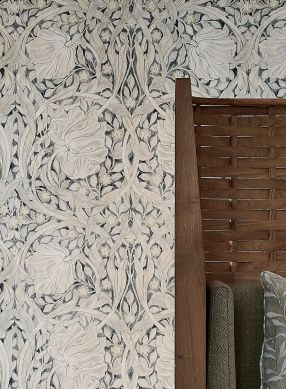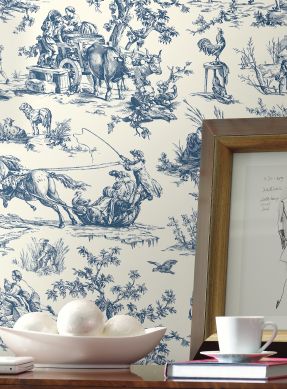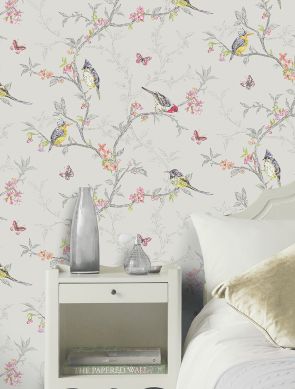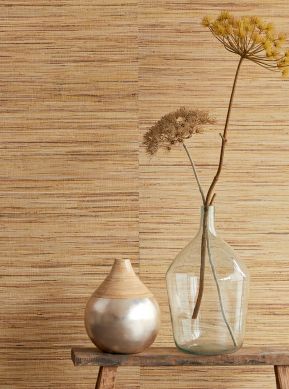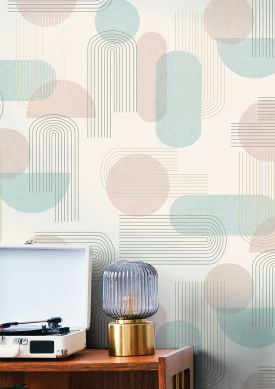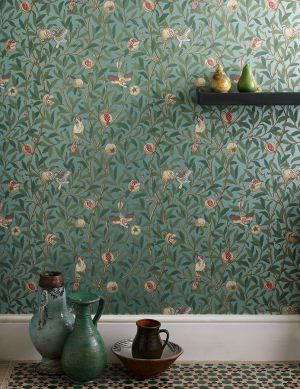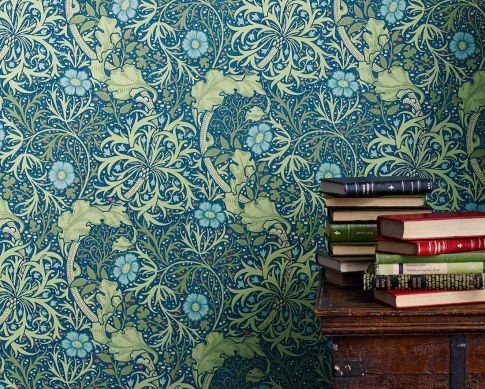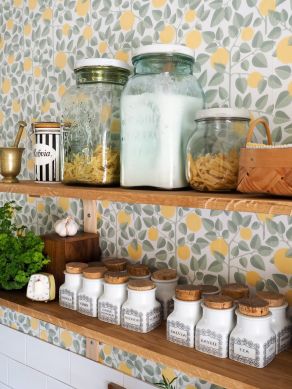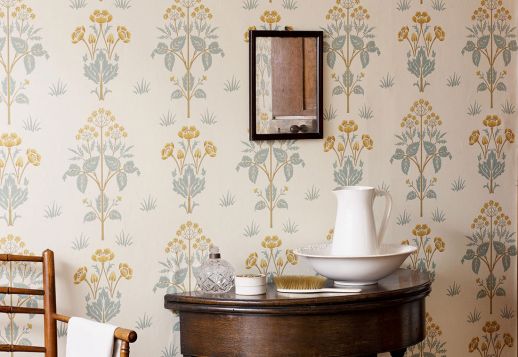Eco-friendly Wallpaper
Eco-friendly Wallpaper: The Guide
The value of a wallpaper is not only measured by price, design, extras and effects. More and more consumers attach importance to sustainable, environmentally friendly and pollution-free wallpapers. The use of raw materials, production conditions, composition of materials and ingredients: all these are important topics when it comes to eco wallpapers. They protect the environment as well as our health and contribute to the resource-saving processing of valuable raw materials.
Table of Contents
- What is eco-friendly wallpaper?
- What are the characteristics of pollutant-free wallpapers?
- Which types of wallpaper are “eco” and pollutant-free?
- Which new developments play a role in the production of eco-friendly wallpaper?
- Which wallpapers are suitable for allergy sufferers?
- How do eco-friendly wallpapers ensure a healthy and natural indoor climate?
- Which wallpapering paste is particularly environmentally friendly?
- What role does the FSC certification play with regard to wallpaper raw materials?
- Which wall paints are suitable for eco-friendly wallpaper?
- What are the production processes of wallpaper manufacturers with a focus on environmentally friendly methods?
- Which wallpaper manufacturers produce eco-friendly wallpaper (predominantly or exclusively)?
- Our tips & design ideas for eco-friendly wallpaper
What is eco-friendly wallpaper?
Eco-friendly wallpaper is produced in an environmentally conscious manner, i.e. without petroleum-based raw materials and using renewable materials from controlled cultivation. Recycling and water-based printing inks are also decisive factors.
Avoiding petroleum-based raw materials
Carbon from fossil raw materials such as natural gas, oil or coal poses a problem for the environment and our health (greenhouse gas carbon dioxide) and should therefore be avoided in the production of environmentally friendly wallpaper. Oil-based raw materials for the production of plastics (e.g. PVC for vinyl wallpaper) are therefore replaced with renewable raw materials.
Use of renewable raw materials
Wood (and cellulose obtained from it) are important raw materials for the production of wallpaper. Renewable plants such as grass, cork, bamboo or hay are also processed in the course of wallpaper production. The so-called biomass, from which bioenergy for electricity, heat and fuels is generated, plays a major role in the subsequent disposal process. It can be reused for the production of new products.
Sustainable, controlled cultivation
Wood from sustainably managed forests and forestry operations that work according to high ecological and social standards forms the basis for environmentally friendly wallpaper. No wood is taken from forests that are particularly worthy of protection, such as tropical or boreal virgin forests. Strict external monitoring of the environmental specifications is essential.
Resource-saving processing and recycling
In the production of paper-based wallpaper, a high proportion of waste paper turns the ecological concept into reality. In this context, paper-based wallpaper made from recycled paper performs far better than paper-based wallpaper made from primary fibres which use wood as a source of fibre raw material. The entire production process is geared towards reducing water and energy consumption, using renewable energies, and keeping resource consumption and wastewater pollution at a minimum level.
Water-based printing inks
Solvent-free, water-based printing inks are the substance of choice for eco-friendly wallpaper. They are a mixture of cellulose starch, lime, water and colour pigments which do not harm people or the environment. Your nose will tell you the difference between solvent-based and water-based wallpaper inks and dyes.
Environmentally friendly disposal
Used/removed paper-based wallpaper or unused surplus wallpaper waste must not be disposed of in the waste paper but in the residual waste bin. Since it has to be wet-strength paper for processing, it does not dissolve in water, which means that paper recycling is not an option. Nevertheless, energy can still be generated from old wallpaper through waste incineration and flow back into the energy cycle.
What are the characteristics of pollutant-free wallpapers?
Pollutant-free wallpaper is free of carcinogenic substances as well as of those endangering reproduction and altering genetic material. It does not contain softeners, harmful fillers, binding agents and solvents, various preservatives, VOC, azo dyes and formaldehyde.
Free of plastic components and plasticisers
Environmentally and health-aware wallpaper does not contain any plastic components or low-volatile phthalates (plasticisers which can occur in vinyl wallpaper). These substances continuously evaporate and have a negative effect on the hormonal balance. Waterproof wallpaper surfaces made of environmentally neutral foam are a great alternative.
Free of harmful fillers
Fillers can be contained in wallpaper coatings of synthetic wallpapers to improve the plasticity and workability or to compact the structure. Avoiding these substances is a typical characteristic of non-toxic wallpapers. Alternatives made from natural mineral fillers are becoming increasingly important in the wallpaper industry.
Free of binders
Binders are used to bond and strengthen material components and to improve the durability and abrasion resistance of wallpaper dyes. Binders can contain softeners or other substances that are harmful to our health. Non-toxic wallpaper does not contain synthetic and chemical binders and instead relies on natural binders such as milk protein.
Free of solvents
Volatile solvents and compounds are used to separate or dilute water-insoluble substances. In terms of wallpaper, these can occur in paints and dyes. Solvents usually emit an intense, almost aggressive odour and are absorbed through the mucous membranes. They can cause dizziness, nausea and breathing difficulties.
Free of certain preservatives
Paints, coatings and finishes are often mixed with preservatives to ensure that they are long-lasting and hygienic. For the sake of our health, it makes sense to choose wallpaper with colours and other components that do not contain any preservatives as those can cause allergies.
Free of volatile organic compounds (VOC)
Volatile organic compounds can escape from wallpapers with plastic coatings, dyes or special surface treatments. They are released into the ambient air and inhaled. From temporary effects to long-term negative impacts, VOCs are damaging to our health. These substances are not used in pollutant-free wallpapers.
Free of dangerous azo dyes
Synthetic azo dyes are made with pigments containing mercury, lead, cadmium or chromium VI compounds. Dyes enriched with heavy metal components are considered carcinogenic, sometimes even toxic, which is why they are not used in pollutant-free wallpapers. In terms of wallpapers, these substances have been banned since 1980.
Free of formaldehyde
Formaldehyde is found in dyes, paints, glues and adhesive products and increases the wet tear resistance of paper wallpapers. Many health problems are associated with this substance, which is why pollutant-free wallpapers are produced without chemical additives that contain anaglypta or formaldehyde. Formaldehyde occurs naturally in wood, although far below the threshold values, and the formaldehyde emission by wallpaper into the ambient air is very low.
Which types of wallpaper are „eco“ and pollutant-free?
The raw materials and their composition determine whether wallpapers can be classified as ecological and pollutant-free. Paper and wood-chip wallpaper, wallpaper made of natural materials or cellulose as well as new types of natural non-woven models fulfil these criteria.
Paper-based wallpaper
Eco-friendly, paper-based wallpapers have no coating and the proportion of waste paper is at least 60%. Pollutant-free paper wallpapers have not been printed on and are single-layered, with next to no harmful emissions. To increase the wet tear resistance, substances which may contain formaldehyde are sometimes added. Biocides, which are intended to prevent slime formation in the water circuit of the paper machine, are also used in the production process.
Wood-chip wallpaper
With a waste paper content of 80%, wood-chip wallpaper is at the top of the list of wallpaper types which are environmentally friendly and harmless to our health. Wood fibres are added to three layers of paper, giving the wallpaper its special, grainy structure. If the raw wood for the primary fibre and the added wood-chips comes from sustainable forestry, the ecological value increases.
Natural materials on a paper carrier
Eco-friendly wallpapers also include those in which purely natural materials are laminated onto a paper carrier. The focus is on natural fibres made of grass, bamboo, sisal, hemp, jute and cork. The natural materials cannot be treated with toxic fungicides. For these wallpapers, cork is not glued onto the carrier/base layer with synthetic resins but as "backing cork" with its own resins.
Non-woven wallpaper base made of natural materials
When it comes to non-woven wallpaper base, much has changed in recent times. Today, it can be made purely from renewable, plant-based raw materials; a good example is the first completely compostable wallpaper Veruso Lino, made of flax and viscose. This model does not contain any additives such as binding agents, dyes or synthetic fibres. In order for its positive characteristics to fully unfold, it should not be painted over.
Non-woven wallpaper base made of cellulose
Conventional non-woven wallpaper base is made of cellulose with a proportion of synthetic or natural textile fibres. The two components are compacted with a binding agent. Environmentally friendly non-woven wallpaper base made exclusively of cellulose has only recently been introduced to the market. These types are currently only available for painting over. A prototype for printing wallpaper patterns on is still a work in progress.
Which new developments play a role in the production of eco-friendly wallpaper?
Eco-friendly wallpapers are constantly evolving and adapting to new possibilities, especially with regard to recycling, health and resource conservation. Compostable, vegan, organic, biological and climate-neutral wallpapers are all available today.
Compostable wallpaper
Wallpaper models such as Veruso Lino, for example, which are made purely of plant fibres and not painted or sealed, dissolve by themselves over time as a result of the natural process of decomposition. They are therefore compostable and leave no environmentally harmful residues which would have to be recycled at a significant cost, requiring high resource consumption.
Vegan wallpaper
For the production of vegan wallpaper or vegan wallpapering paste, ingredients which are of animal origin or have been tested on animals must not be used. Ideally, all wallpaper components consist purely of vegetable substances. In the future, a corresponding seal awarded by an independent testing organisation would be desirable to distinguish these wallpaper models.
Organic wallpaper
For the production of organic wallpaper, natural, untreated materials such as hay, moss or meadow flowers are dried after harvesting and pressed onto a flax carrier layer. No chemicals are used for the drying process, the conservation and the sealing of the surface. This prevents the release of allergens and preserves the natural fragrance component.
Biological wallpaper
Biological wallpapers are toxin-free and made of renewable vegetable raw materials or recycled fibres which are largely free of substances harmful to our health and the environment. In addition to the materials, the paints, binders and other additives are also environmentally friendly and completely or predominantly biodegradable.
Climate-neutral wallpaper
The term CO2-neutral wallpaper means that all emissions from the production process are offset by the planting of trees in the producer country or, for example, in Brazil. Many manufacturers of wood-chip wallpapers have started this compensation process and launched the first climate-neutral wallpaper models on the market.
Plastic-free packaging
"Paper instead of plastic foil" is the motto of environmentally friendly wallpaper packaging. Because the avoidance of plastic waste - which pollutes the environment and harms people - begins with each manufacturer's product packaging. Ideally, all packaging material should consist of recycled paper.
Which wallpapers are suitable for allergy sufferers?
For allergy sufferers, many substances (including completely natural ones) cause unpleasant physical reactions such as coughing, sneezing, itching or even breathing problems. Smooth surfaces as well as toxin-free wallpapers are usually the best choice. Allergy sufferers should avoid wallpaper models with grass components.
Smooth surfaces
Allergy sufferers should choose wallpaper types with smooth surfaces which no dust or pollen can stick to. The fine (respirable) dust load in the air must be kept at a minimum, which is why textile wallpapers are not recommended for allergy sufferers. It should be possible to wipe surfaces down with a damp cloth or sponge to remove any build-up.
Chemical-free wallpaper
Chemical substances used in the production of wallpaper, including preservatives and paints containing solvents, can cause allergies. Chemical-free wallpapers, for example those in which natural resin varnishes and water-soluble paints have been used, are the best choice for allergy sufferers. Water-soluble dispersion paints are available to add a splash of colour.
Grass wallpaper - not recommended!
Allergy sufferers should avoid wallpaper models containing grass or hay. Untreated grass wallpaper in particular can cause hay fever in people with allergies. When in doubt, it makes sense to order a wallpaper sample and put it to the test. For those who don't want to do without the special look of grass wallpaper, there are models with deceptively realistic imitation prints.
How do eco-friendly wallpapers ensure a healthy and natural indoor climate?
In children's rooms and bedrooms, eco-friendly wallpaper can make a valuable contribution to a healthy living environment. They should have a permeable/breathable surface and be made of moisture-regulating material.
Permeable surface
A wallpaper surface that is open to diffusion prevents any humidity in the air from being deposited on the surface, providing a breeding ground for harmful micro-organisms and mould. Paint coatings should be used sparingly here, because the more often the surface is painted, the more the vapour diffusion quality is reduced.
Moisture-regulating material
Open-pored wallpaper materials provide natural moisture regulation. They absorb moisture from the ambient air, retain it and gradually release it back into the room. This ensures optimum air circulation, which also prevents the formation of mould and keeps the room climate at a healthy level.
Breathability
To ensure the breathability of eco-friendly wallpaper, no substances that impair its climate-regulating properties may be used. If synthetic resin adhesive is applied between natural fibres and a paper carrier layer, the breathability of natural wallpaper is somewhat reduced. Casein or natural resin adhesive are better choices for bonding the materials.
Mould prevention
The coldest parts of an internal wall (often exterior and window walls) are most susceptible to moisture, which in turn is a breeding ground for mould. When choosing wallpaper, it is important to ensure that it has breathable and moisture-regulating properties. The moisture on these walls should not be sealed in with the wrong wallpaper or paint.
Which wallpapering paste is particularly environmentally friendly?
Not only wallpapers can make a contribution to the preservation of the environment: wallpapering paste should also be made of natural, sustainable materials. These days, there are eco-friendly pastes made of pure methyl cellulose which are also free of artificial resins and preservatives.
Pure methyl cellulose
Wallpapering paste made of pure methyl cellulose is available in powder form. It is stirred into water and within a few minutes forms a lump-free, homogeneous solution with a thick consistency and strong adhesive power. Methyl cellulose is obtained in a complex process from cellulose, which in turn comes from wood fibres.
Free from artificial resins
Those who are keen to use eco-friendly wallpapering paste products should make sure that they are free of artificial resins. These often serve as adhesive strength enhancers. For all wallpapers that require a particularly strong paste, a wall covering adhesive based on natural rubber is recommended. It is suitable for wallpapers made of coarse fabric, textile, non-woven materials, metal, PVC or heavy paper-based models.
Free of preservatives
Healthy, environmentally conscious paste should not contain any preservatives. Of course this means that it is not as durable and must be used up more quickly than ordinary paste containing antibacterial and fungicidal substances. Our tip: Only mix as much wallpapering paste as can be used within a reasonable time.
What role does the FSC certification play with regard to wallpaper raw materials?
"FSC" is the certification system for the forestry industry. The forest as a valuable ecosystem worthy of protection and with all its functions for flora and fauna is at the very centre of this system.
Forestry certification system
FSC is the abbreviation for Forest Stewardship Council, a non-governmental, non-profit organisation based in Bonn (Germany). Its seal of approval stands for the safeguarding of important environmental and social standards in the forest context. The certificate guarantees that wood and paper production is based on responsibly managed forests.
Protection of the ecosystem "forest"
The main focus of the FSC is the protection of the forest ecosystem. It is of vital importance to preserve the ecological functions of the forests from which wood is taken and to protect animal and plant species threatened with extinction. For this reason, strict principles and stringent criteria are applied to the management of forests. Complete documentation & monitoring is mandatory.
Which wall paints are suitable for eco-friendly wallpaper?
Only wall paints that are free of toxic solvents or additives should be used. Natural resin dispersion paints, distemper paints, casein paints, linseed oil paints and silicate paints are all available.
Natural resin dispersion paints
Natural resin dispersion paints are among the best-known and most common natural wall paints. They consist of a mixture of pigments dissolved in water which are bound by natural resins (instead of synthetic resins). The higher the proportion of natural resin, the more abrasion- and moisture-resistant the paint.
Distemper paints
Traditional distemper is made from natural chalk or limestone powder with water-soluble glue as a binding agent. Distemper paints are smudge-proof and provide good coverage, but must be washed off before repainting with other types of paint. Colour pigments are stirred in for colour tinting.
Casein paints
Casein is the main component of milk protein (80%) and a natural binder for casein paint products. They consist of water, casein, pigments and lime. For wet rooms, their suitability is limited. They can produce ammonia on alkaline surfaces. Due to its limited durability, freshly mixed casein paint should be used immediately.
Linseed oil paints
Pure linseed oil paint consists of degummed, heated or cold-pressed linseed oil and pigments. This type of paint is natural, solvent-free and biologically pure. It is traditionally used for wood painting, especially in Scandinavia. Linseed oil paints also score points in terms of breathability.
Silicate paints
Silicate paints contain potassium silicate as a binder. Potassium silicate is produced by melting quartz sand (silicate) and potash (potassium carbonate) and adding water. Silicate paints are open to vapour diffusion and have a fungicidal effect. During painting, they bond non-detachably with the surface, which must be mineral in order for the paint to stay on.
What are the production processes of wallpaper manufacturers with a focus on environmentally friendly methods?
More and more wallpaper manufacturers accept their ecological responsibility. This is reflected by internal waste recycling, water treatment, packaging made of recycled cardboard and energy-saving production processes.
Internal waste recycling
Environmentally conscious manufacturers recycle up to 100% of the dry waste created during production. This means that any paper waste generated is directly added back to the production cycle. Internal recycling also pays off economically, as the residual materials used are generally particularly pure and free of contaminants.
Water treatment
Avoidance before salvaging and before disposal: this, in short, is the hierarchy of waste. In this context, economical water consumption is the first step for producers because it results in less liquid waste. In addition, more than 97% of liquid waste can be recycled. Larger wallpaper factories often have their own water treatment systems.
Packaging made of recycled cardboard
As packaging material, recycled cardboard protects the environment because it is made from waste paper. This includes anything from the cardboard packaging of wallpaper rolls up to large pallets. It results in more than 75% recycled raw materials being used.
Energy-saving production processes
The targeted, efficient use of energy which connects as many production steps as possible distinguishes environmentally conscious wallpaper manufacturers. In this context, the use of renewable energy or bioenergy is just as important as the compliance with the strict requirements stipulated for environmental certificates.
Which wallpaper manufacturers produce eco-friendly wallpaper (predominantly or exclusively)?
Manufacturers are increasingly focussing on the production of eco-friendly wallpapers and paints. Among those already doing something for the environment, the climate and healthy living are manufacturers like Erfurt & Sohn, Farrow and Ball, Pihlgren ja Ritola Oy and Little Greene.
Erfurt & Sohn
German family-owned company Erfurt & Sohn, based in Wuppertal, is considered the inventor of wood-chip wallpaper and one of the "green" companies that are committed to sustainability and ecological responsibility. The product range includes 100% pure paper-based embossed wallpapers, breathable PVC-free non-woven wallpapers and, brand new as of 2020, climate-neutral wallpapers.
Farrow and Ball
This traditional British manufacturer of high-quality wallpaper and fine paints based in Dorset works according to strict ecological and health-conscious criteria. The paper for the sought-after wallpapers comes from sustainably managed forests and responsible production. Patterns are added with their own water-based inks.
Pihlgren ja Ritola Oy
Historical and nostalgic patterns are the forte of this Finnish company which uses only unbleached paper-carriers and natural paints for its wallpapers. The popular models are produced on old original machines from 1875 using surface printing technology. Minor flaws, subtle inaccuracies and deviations are intentional features that guarantee uniqueness.
Little Greene
British paint and wallpaper manufacturer Little Green has been in business since 1773. The company is committed to environmentally friendly and socially responsible production. It is known for its colourful wallpapers based on historical patterns with a modern touch. Traditional printing methods, high-quality paper and water-based inks support the ecological concept.
Our tips: Design ideas for eco-friendly wallpaper
- How to recognise eco-friendly wallpaper: Sustainable, healthy wallpapers boast relevant seals, certificates and testing standards, which are also awarded for the best possible ecological efficiency. Among the most relevant are: The Blue Angel, eco-Institut’s “Label for Textiles”, Natureplus, Reach, Greenguard or STANDARD 100 by Oeko-Tex.
- Natural field and meadow grasses for rooms with an outdoor feel: Whether modern, minimalist, Asian or rural living styles - naturally grown grasses on paper carriers conjure up a natural, original flair with positive effects on the indoor climate. Evergreen plants add to the ambience.
- Veruso Lino for highest living comfort: The first fully compostable wallpaper is made of flax and viscose and highly durable, breathable, soft to the touch and naturally structured. Its delicate cream shade combines elegance with originality. Only organic wallpapering paste should be used for hanging it.
- The eco-wallpaper principle for children's rooms: Introduce the little ones to the subject of environmental protection and health in an easy, playful manner. This can be achieved with eco-friendly paper-based wallpapers which they can decorate with water-soluble natural paints to their heart's content. Use only harmless wallpapering paste made of pure methyl cellulose.






